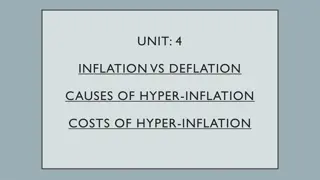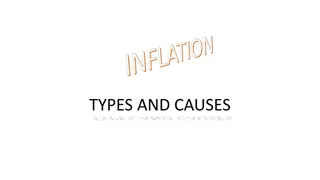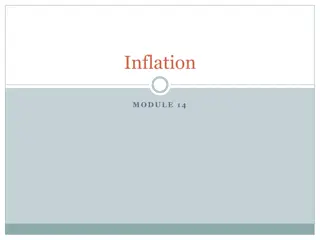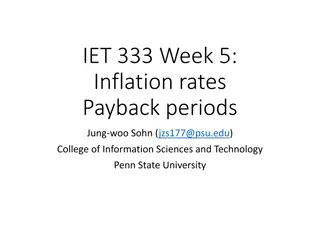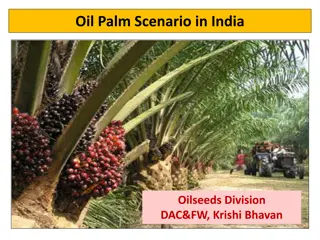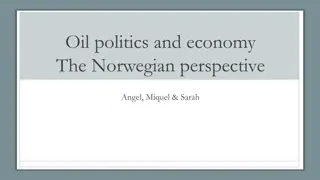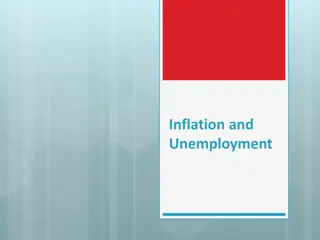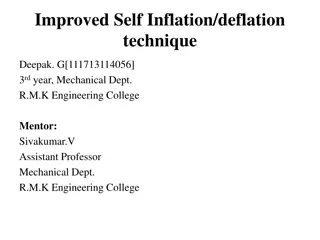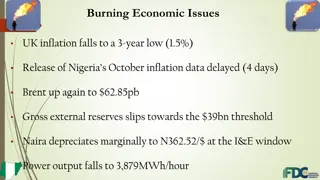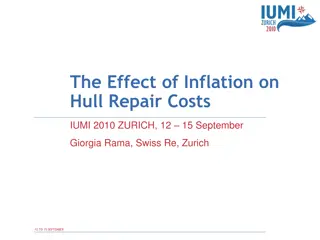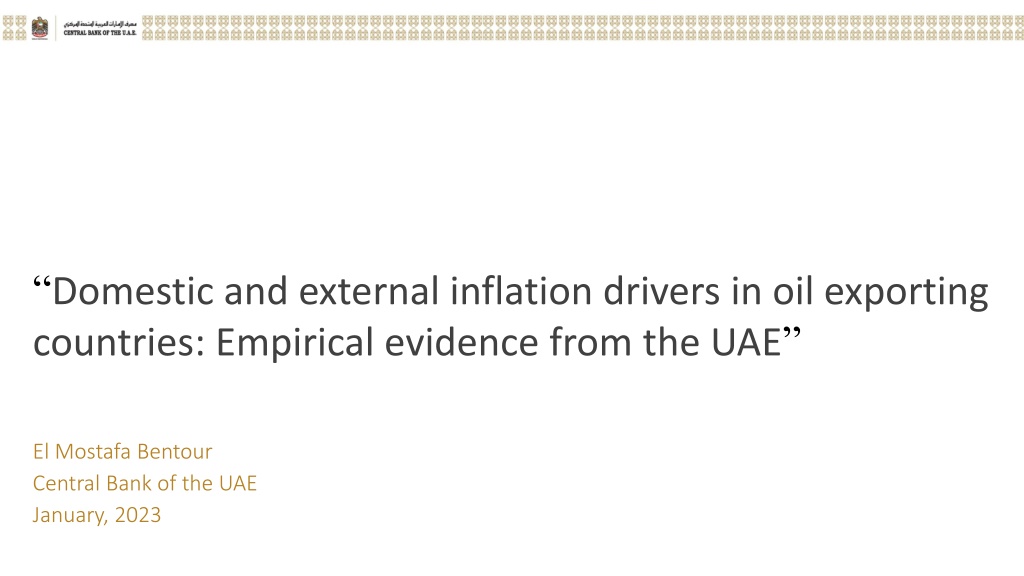
Drivers of Inflation in Oil Exporting Countries: Evidence from the UAE
Explore the domestic and external factors influencing inflation in UAE, focusing on the impact of foreign commodity price shocks, including oil prices. The study delves into inflation drivers specific to oil-exporting nations and provides empirical insights for policymakers.
Download Presentation

Please find below an Image/Link to download the presentation.
The content on the website is provided AS IS for your information and personal use only. It may not be sold, licensed, or shared on other websites without obtaining consent from the author. Download presentation by click this link. If you encounter any issues during the download, it is possible that the publisher has removed the file from their server.
E N D
Presentation Transcript
Domestic and external inflation drivers in oil exporting countries: Empirical evidence from the UAE El Mostafa Bentour Central Bank of the UAE January, 2023
TABLE OF CONTENTS TABLE OF CONTENTS 1. Introduction 2. Inflation drivers for oil-exporting countries: the UAE case 3. Model specification 4. Methodology of estimations 5. Summary of results 6. Interpretation of results 7. Conclusion and policy recommendations
1. Introduction 1. Introduction - Inflation expectations and inertia persistence. - Foreign international commodity shocks (Food, energy prices) and their pass-through channels. - Inflation expectations could be influenced by foreign oil prices shocks. Objective: - Examine the main domestic and foreign determinants of inflation in the UAE taking into account its own idiosyncrasies.
2. Inflation drivers for oil 2. Inflation drivers for oil- -exporting countries: the UAE case exporting countries: the UAE case Global and macroeconomic foreign drivers - Oil prices: Fiscal channel through government spending, Exchange rate through import prices, base / Anchored expectations. Accumulated reserves / monetary policy channels: Monetary - Other foreign shocks: Global demand/inflation Supply shocks Technology shocks (long run), Inertia. Diagram Legend: : Purely exogenous shock (variable). : Endogenous variable (domestically determined). : Exogeneity depends on the target (Stock of Money, Interest rate, Exchange rate). : Direct impact/shock (from the source variable to the end arrow variable). : Indirect impact. ( ) : Increase (Decrease). : The sign of the impact is determined by the result of a mixture of variables. Source: Author s construction. Fiscal channel Exchange rate and monetary policy channels Other channels
2. Inflation drivers for oil 2. Inflation drivers for oil- -exporting countries: the UAE case (Cont.) exporting countries: the UAE case (Cont.) Domestic drivers of inflation in the UAE: Global and Sectoral Analysis Customer expenditure basket weights for the UAE Customer expenditure basket weights for the UAE Restaurants and Restaurants and accommodation accommodation; ; 4.6% 4.6% Fixtures and Fixtures and housing housing maintenance maintenance; ; 5.1% Recreation, sport Recreation, sport and culture and culture; ; 3.1% 3.1% 5.1% Clothing and Clothing and footwear footwear; ; 5.2% Potential domestic drivers of inflation to examine : 5.2% Information and Information and communication communication; ; 5.9% 5.9% Housing rents and Housing rents and related utilities related utilities; ; 35.1% 35.1% Housing prices, Private Wages, Education Education; ; 7.6% 7.6% Government expenditures, Non-oil output gap Transport Transport; ; 12.7% 12.7% Food and Food and beverages beverages; ; 12.2% 12.2% Money supply. Health, protection Health, protection and insurance and insurance; ; 8.4% 8.4% Source: Constructed from FCSC data
3. Model specification 3. Model specification A standard hybrid New Keynesian Phillips Curve (NKPC) for inflation for an open economy (Kamber et al. 2022): ?? ?? ?? ?? ??; ??? YoY Percent change of the CPI Inflation expectations (Assumed = ?? 1) YoY Percent change of the exchange rate (NEER) YoY Percent change of the oil prices Non-oil GDP and World GDP output ??= ?0+ ?1.???+ ?1 ??+ ?2 ???+ ?1. ??+ ?2. ?????+ ?? ? ??? For the UAE: ??= ?0+ ?1?? 1+ ?1 ??+ ?2 ???+ ?1. ??+ ?2. ?????+ ?3??+ ?1 ??+ ?2 ??+ ?3 ??+ ?? ?? Interest rate (FFR) / or Money supply growth. Government expenditures Wages in the private sector Housing price inflation ?? ?? ?? Data sources, descriptive statistics (Appendix 1)
4. Methodology of estimations 4. Methodology of estimations Challenging issues: Data and variables: Tradeoff between short samples of some variables and large number of potential determinants. Econometric issues: Multicollinearity and serial correlations. For this, we proceed in three steps by: 1. Test the domestic determinants of inflation (Model 1) using two procedures of variable selection method: The stepwise backward/forward regressions and the Coefficients Variance Decomposition (CVD) (Model 2). Repeat the 1st step for foreign determinants (Model 3), to select the significant foreign drivers (Model 4). 2. 3. Third, mix the two sets of selected determinants and run the final model using the same selection methods (model 5). Results for the CVD selection method are in Appendix 2.
5. Summary of Results 5. Summary of Results Estimation results Model 1 Model 2 Model 3 Model 4 Model 5 Variable Constant, ?0 Coefficient Probability Coefficient Probability Coefficient Probability Coefficient Probability Coefficient Probability 0.6016 0.1086 0.224261* 0.0736 0.0053 0.97 0.2255 0.1132 0.3650 0.008 Inertia, ?? 1 0.6737*** 0.0000 0.713683*** 0.0000 0.7721*** 0.0000 0.8059*** 0.0000 0.6578 0.0000 Housing, ?? 0.0732** 0.0169 0.052636** 0.0138 .. .. .. .. 0.0754** 0.0027 Wages, ?? Non-oil gap, ?? Gov. Spending, ?? Money M3, ?? Oil prices, ????? NEER, ?? 0.0429* 0.0622 0.050072*** 0.0080 .. .. .. .. 0.0361* 0.0675 0.0767** 0.0111 0.084653** 0.0158 .. .. .. .. 0.0748* 0.0656 -0.0046 0.2644 .. .. .. .. .. .. .. .. -0.0553 0.2468 .. .. .. .. .. .. .. .. .. .. .. .. 0.0068 0.1688 0.0117*** 0.0003 0.0067** 0.0475 .. .. .. .. 0.0840** 0.0273 0.0953*** 0.0079 .. .. Interest rate, ?? World GDP gap, ??? .. .. .. .. -0.3161** 0.0468 -0.3419** 0.0457 .. .. .. .. .. .. 0.0905* 0.0645 .. .. .. .. Dum. 2018:q1, ?1 2.3644*** 0.0000 2.2338*** 0.0000 3.0106*** 0.0000 3.0806*** 0.0000 2.0390*** 0.0000 Dum. 2019:q1, ?2 -3.0728*** 0.0000 -3.4306*** 0.0000 -3.3116*** 0.0000 -3.2825*** 0.0000 -3.4772*** 0.0000 Adjusted R-squared 0.9099 0.9117 0.8902 0.8845 0.9110 Durbin Watson 2.0155 1.9953 1.8861 1.7838 2.0413 *, **, ***: Significant at 10%, 5% and 1% respectively. Model 1 includes domestic drivers with constant and inertia, model 2 is the chosen model for domestic drivers after appropriate of tests, model 3 model for all foreign variables, model 4 is the chosen model after appropriate tests, model 5 is the chosen model after mixing all the domestic and foreign drivers.
5. Summary of Results (Cont.): VAR(1) model for domestic and foreign drivers of inflation in the UAE 5. Summary of Results (Cont.): VAR(1) model for domestic and foreign drivers of inflation in the UAE Inflation responses following impulses of selected domestic inflation determinants. Inflation responses following impulses of selected foreign inflation determinants Response to Cholesky One S.D. (d.f. adjusted) Innovations Response to Cholesky One S.D. (d.f. adjusted) Innovations 99% CI using Standard percentile bootstrap with 999 bootstrap repetitions 99% CI using Standard percentile bootstrap with 999 bootstrap repetitions Response of INF to NEERG Innovation Response of INF to OPG Innovation Response of INF to HINDG Innovation .4 .2 1.2 .6 .0 .4 -.2 0.8 -.4 .2 -.6 0.4 5 10 15 20 .0 Response of INF to FFR Innovation 0.0 -.2 .4 .2 -0.4 -.4 .0 2 4 6 8 10 12 14 16 18 20 22 24 2 4 6 8 10 12 14 16 18 20 22 24 -.2 -.4 Response of INF to WPG Innovation Response of INF to GAP Innovation -.6 .6 .6 -.8 5 10 15 20 .4 .4 Response of INF to WGDPG Innovation .2 .6 .2 .4 .0 .2 .0 -.2 .0 -.2 -.2 -.4 -.4 -.4 -.6 -.6 5 10 15 20 2 4 6 8 10 12 14 16 18 20 22 24 2 4 6 8 10 12 14 16 18 20 22 24 We run a set of additional tests for robustness check: Coefficients stability, In-sample forecasts comparisons, Quantile forecasts, . (Appendix 4).
6. Interpretation of results 6. Interpretation of results Contributions of the main determinants to inflation in the UAE The main drivers of inflation are: Oil Prices 12.3% A persistent inflation inertia, Private Wages 5.2% Housing prices, Non-oil GDP gap 7.2% Private Wages, Inertia (expectations) 51.0% Non-oil output gap, Oil prices. Housing prices 24.2%
7. Conclusion and policy recommendations 7. Conclusion and policy recommendations Despite the relatively high degree of openness and oil abundance, important drivers of inflation in the UAE comes rather from domestic than foreign factors, particularly real estate sector and wages. Foreign shocks to inflation are mainly from international oil prices. Accordingly, important policy implications and recommendations to draw from these results are: Anticipating the supply and demand of housing to keep inflation under control and avoid forming housing price bubbles. Attract high skilled talent with comparative salary advantages and productivity, while continuing the process of Emiratization. Continue the process of economic diversification and further disentangling from oil price volatility.
THANK YOU THANK YOU
Appendix 1. Data Sources and Covariance Appendix 1. Data Sources and Covariance Table 1. Variables sources, ranges and frequencies. Variable Inflation Non-oil GDP Housing index Rent prices Federal funds rate Private wages Oil prices NEER Government spending Money (M3) World GDP World inflation Sample range 2009q1-2022q2 2012q1-2022q2 2013:1-2022:9 2009:1-2022:9 2007q1-2022q2 2010q1-2022q3 2001:q1-2022q3 1994:1-2022:9 2013q1-2022q3 2009:1-2022:9 2007q1-2022q1 2007q1-2022q1 Frequency Monthly Quarterly Monthly Monthly Quarterly Monthly Monthly Monthly Quarterly Monthly Quarterly Quarterly Source FCSC FCSC DLD REIDIN FedSLouis CBUAE EIA BIS MoF CBUAE OECD FedSLouis Table 2. Covariance Analysis: Kendall's tau correlation test Tau-b HINDG NOGAP WPG GEG M3G NEERG OPG FFR WGDPG (Probability) tau prob tau prob tau prob tau prob tau prob tau prob tau prob tau prob tau prob 1.0000 ----- 0.1576 0.2373 0.0739 0.5865 0.0148 0.9253 0.0049 0.9850 0.1034 0.4418 0.0345 0.8073 -0.3753 0.0046** 0.0046** 0.2956 0.0256** 0.0256** HINDG 1.0000 ----- 0.0788 0.5609 0.2365 0.0747* 0.0747* 0.1182 0.3780 0.0690 0.6125 0.2266 0.0878* 0.0878* 0.1333 0.3200 0.2709 0.0409** 0.0409** NOGAP 1.0000 ----- -0.2020 0.1287 0.0837 0.5359 0.1034 0.4418 0.0640 0.6391 -0.1630 0.2226 0.1478 0.2684 WPG 1.0000 ----- -0.0049 0.9850 0.1626 0.2227 -0.1330 0.3201 0.0049 0.9850 0.0099 0.9551 GEG 1.0000 ----- 0.0148 0.9253 0.1823 0.1709 0.1086 0.4197 -0.0493 0.7215 M3G 1.0000 ----- -0.3793 0.0041** 0.0041** 0.0889 0.5113 -0.1675 0.2088 NEERG 1.0000 ----- 0.0988 0.4643 0.4926 0.0002*** 0.0002*** OPG 1.0000 ----- -0.1728 0.1954 FFR 1.0000 ----- WGDPG
Appendix 2. Coefficient Variance Decomposition (CVD) Appendix 2. Coefficient Variance Decomposition (CVD) Table 3. Coefficient Variance Decomposition for model of domestic inflation drivers (model 2) Table 3. Coefficient Variance Decomposition for model of domestic inflation drivers (model 2) Step 1: All variables introduced Step 1: All variables introduced Eigenvalues 0.2420 0.0117 0.0012 Condition 0.0001 0.0020 0.0203 Associated Eigenvalue Variable 1 2 3 C 0.9987 0.0013 0.0000 INF(-1) 0.2887 0.7084 0.0026 HINDG 0.6336 0.3306 0.0175 WPG 0.2658 0.0943 0.3803 GAP 0.1195 0.0609 0.6529 GEG 0.2736 0.3139 0.1890 M3G 0.9156 0.9156 0.0126 0.0536 Step 2: M3g is removed for its high associated eigen value Step 2: M3g is removed for its high associated eigen value Eigenvalues 0.0301 0.0068 0.0006 Condition 0.0010 0.0046 0.0510 Associated Eigenvalue Variable 1 2 3 C 0.9910 0.0088 0.0001 INF(-1) 0.1305 0.8645 0.0007 HINDG 0.0907 0.7701 0.0276 WPG 0.4599 0.1242 0.0130 GAP 0.2825 0.0003 0.7066 GEG 0.5746 0.5746 0.1838 0.0012 Step 3: GEG is removed for its high associated Step 3: GEG is removed for its high associated eigen Eigenvalues 0.0210 0.0073 0.0007 Condition 0.0066 0.0189 0.2073 Associated Eigenvalue Variable 1 2 3 C 0.9826 0.0170 0.0003 INF(-1) 0.1227 0.8730 0.0020 HINDG 0.0755 0.7917 0.0315 WPG 0.0309 0.0121 0.0417 GAP 0.3128 0.0098 0.6607 0.0003 0.0751 0.0001 0.3246 0.0000 0.6502 0.0000 1.0000 Decision Decision rule rule: : 4 5 6 7 In each step, the top line shows the eigenvalues, sorted from largest to smallest, with the condition numbers below. 0.0000 0.0001 0.0030 0.1961 0.1655 0.0413 0.0102 0.0000 0.0000 0.0004 0.0555 0.0010 0.0097 0.0079 0.0000 0.0001 0.0135 0.0071 0.0002 0.0225 0.0001 0.0000 0.0000 0.0014 0.0009 0.0000 0.1502 0.0000 Practically, a smaller condition number than 1%, may indicate a collinearity issue. The rest shows the decomposition proportions. 0.0003 0.1013 0.0001 0.2440 0.0000 1.0000 The proportions associated with the smallest condition number are located in the first column. 4 5 6 0.0001 0.0026 0.0211 0.3850 0.0003 0.0054 0.0000 0.0016 0.0889 0.0180 0.0103 0.0395 value 0.0001 1.0000 0.0000 0.0000 0.0016 0.0000 0.0000 0.1955 The rule is to exclude each variable for which the condition proportion is larger than 0.5. The The CVD CVD method method removed removed: : eigen value 0.0003 0.4246 Money growth (M3) and Government expenditures growth (GEG) for the domestic determinants, 4 5 FFR and World output GAP for the foreign determinants, 0.0000 0.0003 0.0026 0.9129 0.0049 0.0000 0.0021 0.0987 0.0024 0.0118 NEER growth for the overall model.
Appendix 2. Appendix 2. Coefficient Coefficient Variance Decomposition (Conti.) Variance Decomposition (Conti.) Table 4. Coefficient Variance Decomposition for model of external inflation drivers (model 4) Table 4. Coefficient Variance Decomposition for model of external inflation drivers (model 4) Step 1: All variables introduced Step 1: All variables introduced Eigenvalues 0.0824 0.0262 Condition 0.0000 0.0001 Associated Eigenvalue Variable 1 2 C 0.471617 0.517544 INF(-1) 0.067077 0.386525 OPG 0.07555 0.051719 NEERG 0.036656 0.187948 FFR 0.94024 0.94024 0.055867 WGDPG 0.040779 0.320804 Step 2: FFR is removed for its high associated eigen value Step 2: FFR is removed for its high associated eigen value Eigenvalues 0.029217 0.005226 Condition 6.87E-05 0.000384 Associated Eigenvalue Variable 1 2 C 0.9906 0.0066 INF(-1) 0.1945 0.2670 OPG 0.4547 0.4338 NEERG 0.1044 0.7908 WGDPG 0.6016 0.6016 0.1836 Step 3: WGDPG is removed for its high associated eigen value Step 3: WGDPG is removed for its high associated eigen value Eigenvalues 0.01725 0.00381 Condition 0.00058 0.00264 Associated Eigenvalue Variable 1 2 C 0.9865 0.0015 INF(-1) 0.2443 0.2114 OPG 0.2604 0.2491 NEERG 0.1545 0.7507 Table 5. Coefficient Variance Decomposition for model of domestic and foreign inflation drivers (model 5) 0.0061 0.0006 0.0032 0.0011 0.0008 0.0045 0.0000 1.0000 Step 1: All selected variables from model 2 and model 4 are introduced Eigenvalues Condition Associated Eigenvalue 0.059089 5.93E-05 0.010515 0.000333 0.001967 0.001782 0.001126 0.003114 0.000697 0.005031 0.000184 0.019038 3.50E-06 3 0.0054 0.277 0.6181 0.5901 0.003 0.3227 4 5 6 1 0.004506 0.265868 0.129966 0.136637 0.000779 0.167782 0.000932 0.003543 0.049611 0.048657 7.16E-05 0.147893 3.37E-10 7.84E-08 0.075086 8.62E-07 1.35E-11 9.00E-06 1 2 3 4 5 6 7 Variable C INF(-1) HINDG GAP WPG OPG NEERG 0.994942 0.119381 0.429742 0.116111 0.269625 0.011734 0.646162 Step 2: NEERG is removed for its high associated eigen value 0.000994 0.864221 0.373485 0.156248 0.113934 0.508763 0.146581 0.003845 0.007004 0.017548 0.016306 0.160938 3.27E-05 0.200138 0.000189 0.007792 0.008215 0.670006 0.077148 0.214006 0.003245 2.09E-05 2.80E-05 0.108547 0.025774 0.354946 8.68E-06 0.001574 0.062463 0.015549 0.023388 0.000891 0.000805 1.27E-09 4.47E-08 2.48E-07 6.15E-06 1.98E-05 0.13547 6.60E-07 0.0018 0.0011 0.000863 0.002328 2.01E-06 1 0.129104 0.003068 3 4 5 0.0001 0.4344 0.0420 0.0987 0.0841 0.0026 0.1042 0.0387 0.0061 0.1307 0.0000 0.0000 0.0308 0.0000 0.0000 Eigenvalues Condition Associated Eigenvalue 0.023671 0.000166 0.008915 0.00044 0.000848 0.004625 0.000366 0.010727 0.00016 0.024542 3.92E-06 1 1 2 3 4 5 6 Variable C INF(-1) HINDG WPG GAP GEG 0.00244 0.00412 0.00001 1.00000 0.995911 0.030573 0.003153 0.083763 0.098612 0.259743 0.003981 0.96586 0.850763 0.007882 0.001947 0.006838 8.58E-05 0.001098 0.022748 0.898296 0.003738 0.088134 9.44E-06 0.000587 0.02424 0.004441 0.851941 0.12644 1.25E-05 0.001882 0.099085 0.00561 0.043751 0.062241 2.61E-08 2.44E-07 1.14E-05 8.70E-06 1.04E-05 0.456603 3 4 0.0120 0.5442 0.1098 0.0948 0.0000 0.0000 0.3807 0.0000
Appendix 3: Influential observations Appendix 3: Influential observations Equation residuals without dummies 6 4 2 4 0 Influential observations corresponding to the first quarter 2 -2 of 2018 and first quarter of 2019 respectively. 0 -4 -2 The two influential points are detected from residuals and -4 tested using influential statistics test. 2014Q2 2014Q3 2014Q4 2015Q1 2015Q2 2015Q3 2015Q4 2016Q1 2016Q2 2016Q3 2016Q4 2017Q1 2017Q2 2017Q3 2017Q4 2018Q1 2018Q2 2018Q3 2018Q4 2019Q1 2019Q2 2019Q3 2019Q4 2020Q1 2020Q2 2020Q3 2020Q4 2021Q1 2021Q2 2021Q3 2021Q4 2022Q1 Residual Actual Fitted Equation residuals with dummies 6 4 2 1.5 0 1.0 -2 0.5 -4 0.0 -0.5 -1.0 -1.5 2014Q2 2014Q3 2014Q4 2015Q1 2015Q2 2015Q3 2015Q4 2016Q1 2016Q2 2016Q3 2016Q4 2017Q1 2017Q2 2017Q3 2017Q4 2018Q1 2018Q2 2018Q3 2018Q4 2019Q1 2019Q2 2019Q3 2019Q4 2020Q1 2020Q2 2020Q3 2020Q4 2021Q1 2021Q2 2021Q3 2021Q4 Residual Actual Fitted
Appendix 4. Additional tests and robustness check Appendix 4. Additional tests and robustness check Recursive Coefficient Estimates for the UAE inflation model (model 5) Recursive Coefficient Estimates for the UAE inflation model (model 5) In In- -sample forecasts for the three inflation model specifications: Domestic, foreign and combined sample forecasts for the three inflation model specifications: Domestic, foreign and combined selected models selected models 1.2 .9 5 4 .8 0.8 3 .7 0.4 2 .6 1 0.0 .5 0 -0.4 .4 -1 I II III IV I II III IV I I II III IV I II III IV I 2020 2021 2022 2020 2021 2022 -2 -3 Recursive C(1) Estimates 2 S.E. Recursive C(2) Estimates 2 S.E. II III IV I II 2018 III IV I II 2019 III IV I II 2020 III IV I II 2021 III IV I 2017 2022 .20 .20 INF_FORECAST_ALL INF_FORECAST_DOMESTIC INF_FORECAST_FOREIGN INF (Actual) .15 .16 .10 .12 .05 .08 .00 .04 -.05 .00 -.10 I II III IV I II III IV I I II III IV I II III IV I Quantile average forecasts for the UAE inflation model Quantile average forecasts for the UAE inflation model 5 2020 2021 2022 2020 2021 2022 Recursive C(3) Estimates 2 S.E. Recursive C(4) Estimates 2 S.E. 4 3 .2 .015 .1 .010 2 .0 .005 1 -.1 .000 0 -.2 -.005 -.3 -.010 -1 I II III IV I II III IV I I II III IV I II III IV I 2020 2021 2022 2020 2021 2022 -2 Recursive C(5) Estimates 2 S.E. Recursive C(6) Estimates 2 S.E. -3 2015q3 2015q4 2016q1 2016q2 2016q3 2016q4 2017q1 2017q2 2017q3 2017q4 2018q1 2018q2 2018q3 2018q4 2019q1 2019q2 2019q3 2019q4 2020q1 2020q2 2020q3 2020q4 2021q1 2021q2 2021q3 2021q4 2022q1 Note: Note: C(1) is the constant term, C(2) if the inflation inertia (lag), C(3) is the coefficient associated with housing price inflation, C(4) is associated with non-oil GDP gap, C(5) for the private wages and C(6) with oil prices growth. INF_F25 INF_F5025 INF_F75 INF_F5075
Appendix 4. Additional tests and robustness check (Conti.) Appendix 4. Additional tests and robustness check (Conti.) Scaled coefficients (Standardized coefficients) for the selected models Scaled coefficients (Standardized coefficients) for the selected models Model 2 Model 4 Model 5 Standardized coefficient Variable Coef. Coef. Standardized coefficient Coef. Standardized coefficient INF(-1) 0.713 0.711 0.806 0.806 0.657 0.655 HINDG 0.053 0.176 .. .. 0.072 0.242 WPG 0.085 0.135 .. .. 0.076 0.120 GAP 0.052 0.096 .. .. 0.041 0.081 OPG .. .. 0.011 0.242 0.053 0.092 NEERG .. .. 0.095 0.214 .. .. FFR .. .. -0.342 -0.134 .. ..




